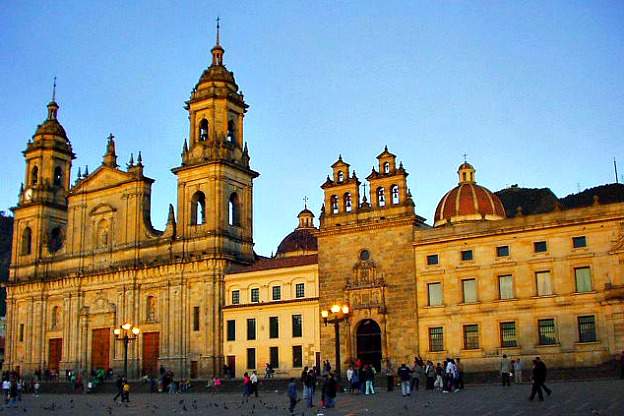
In colonial Latin America, some of the most ambitious music making took place in cathedrals and convents. Bogotá’s first cathedral started out as a simple thatched chapel that was constructed soon after the city’s founding in 1538; however, it went through various incarnations. A more substantial building was finished in 1565, but because of problems with the foundation, it soon collapsed. A third building was attempted in 1572, and while that structure lasted for over 200 years, it was completely destroyed by an earthquake in 1785. It took 38 more years before a replacement building was completed. And, despite damage during the 1948 Bogotazo riots, this is the structure that now occupies Bogotá’s main plaza.
Perhaps as a result of its many reconstructions, the interior of Bogotá Cathedral has relatively little decoration. This is in contrast to another Columbian cathedral, the Church of San Francisco, which boasts a 17th-century gilded main altarpiece and an impressively detailed green-and-gold Mudejar ceiling in the organ loft. Yet, Bogotá Cathedral does have at least one important installation—it houses the tomb of Spanish Conquistador, Jiménez de Quesada, the city’s founder.
Bogotá sits high in the Andes at an elevation of 8,661 feet. An Archdiocese was established there in 1564, and with this distinction, Bogotá gained both funding and influence. The resulting liturgical demands created a city with vast musical resources, and the cathedral’s archives have since become important sources for Latin American sacred music.
Records from the Bogotá Cathedral offer names and information about dozens of notable local musicians. Early in its history, the mestizo priest Gonzalo García Zorro became the Cathedral’s Maestro de Capilla passing on the post to composer Fernández Hidalgo in 1584. Spanish music in both the old and new worlds was inextricably linked throughout this period, and Hidalgo is one of many laudable New World composers who worked in Bogotá. Manuscripts retained in the Cathedral’s rich collection of 16th-century polyphony contain 10 of Hidalgo’s psalm settings, three Salve regina’s and 9 Magnificat settings, which reflect a compositional style concurrent with European musical tastes.
A new organ—whose installation was overseen by Archbishop Bartolomé Lobo Guerrero—ushered in the 17th century at the Bogotá Cathedral. Two prominent Columbian musicians during this time were José de Cascante and Juan de Herrera. After Cascante died, Herrara took over as Maestro de capilla at the Cathedral in January 1703. By then, the position required a regular supply of new music, as well as overseeing the boys choir. Herrara’s prolific compositions show that he must have been a very busy man!
Music heard on this time capsule:









